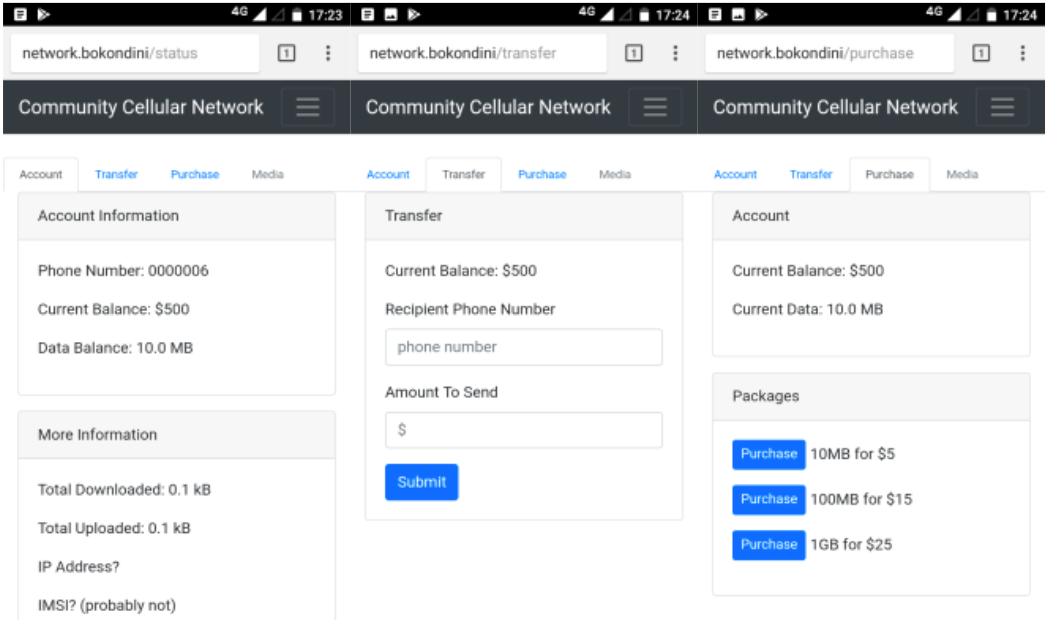Okay, okay, let’s talk about money… everyone’s favorite topic, right? No, but seriously: In all my efforts to get CoLTE up and talking to phones, I didn’t really think about the (glaringly obvious) fact that for us to offer service to the community, we’ll have to pay for it somehow. That means building a billing platform of some sort – a task which has turned out to be both really easy and really hard.
There’s a lot of stuff to cover on this topic, so I’m breaking it up into a series of posts. This post will introduce the basic technical concepts of what we built, how we keep track of network usage, and how customers interact with our system.
Keeping Track of the Bits
One of the really neat things about LTE, as compared to other cell networks, is that in LTE, everything is just IP packets. This actually lets us dramatically simplify the technical part of our billing system: we note the IP address that we assign each use, use ntopng to keep track of how many bytes a specific IP address sends and receives… and that’s it! This takes care of data, obviously, but also does everything else. Text messages? They’re just IMS traffic from one IP address to another, and counted in the data. Phone calls? VoLTE runs over IP, done. What if a user wants to use WhatsApp or Skype instead? We really couldn’t care less – it’s all just data. Count the bytes, multiply it by the rate we choose (we’ll discuss rates in Part 2) and call it a day.
Credit Purchase and Resale
In addition to monitoring network usage, we had to create ways for users to “top up,” or put money on their account, and then purchase service with that money. In the States, accounts are typically post-paid (i.e. you get a bill after the fact) whereas in a lot of other places, including Bokondini, all accounts are only pre-paid (i.e. you pay someone for credit ahead of time, and the network cuts you off if/when you hit zero). In most pre-paid networks, users top up or transfer credit via a text message interface, or in person at a store. However, since our system is LTE, and doesn’t have to be backwards-compatible with 2G, we decided to forego the traditional interfaces in place of just running a locally-hosted website. We ended up building out this site to handle a wide range of tasks, so by going to “network.bokondini” users see a website that provides them with a wide range of information about their account (data consumed, balance remaining, connection status, etc.) and enables them to perform basic operations such as using their current balance to buy a data package.

Minutes as a “Fiat Currency”
To make matters even more interesting, pre-paid phone credit is often re-sold from one user to another, or traded for other goods and services. In Bokondini, there’s an entire retail economy of corner shop vendors that buy large amounts of cell phone credit at a bulk discount and then resell smaller portions to individual shoppers (e.g. “transfer ten dollars of credit, or 100 minutes, from my account to this phone number”) in exchange for cash.
The notion of credit resale actually makes our lives significantly easier, for two main reasons. First off, it creates a clear division between trading credit from one user to another, and “fiat”-ing new credit into the system to be traded. Obviously, the second action has to be very closely supervised, but we can get away with creating a bottleneck here (maybe we only allow one or two people to introduce new credit into the system) because the credit will then be traded and disperse through the community via these resellers.
Second off, the notion of “fiat” here makes us a lot safer and more resilient to many different scams and attacks. This is because with the one exception of creating credit, no real money ever changes hands or goes away. If one user cheats or steals from the account of another user, or hacks the system to add credit to their account, we can simply undo the transaction, or manually edit the balances ourselves: no value is ever actually lost for good.
All right – that’s enough money talk for today. Stay tuned for Part 2, coming out soon, in which I talk about the different possible billing models, what our expenses look like, and how we need to generate revenue.